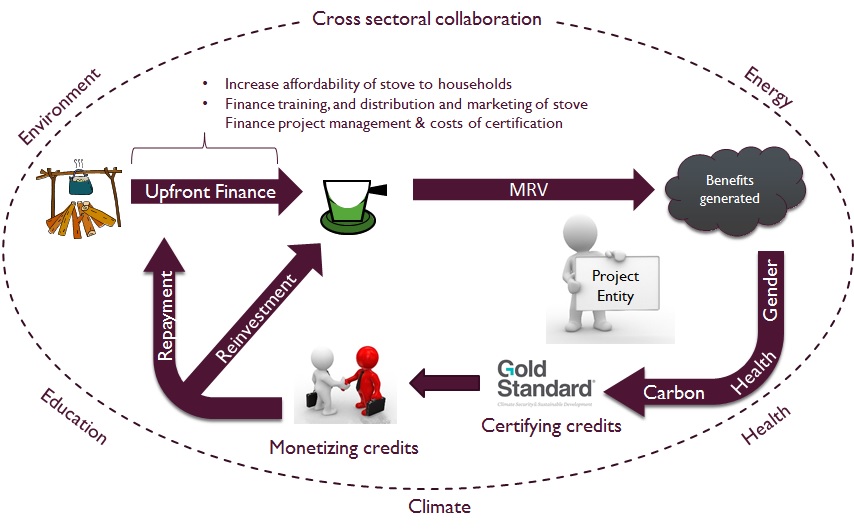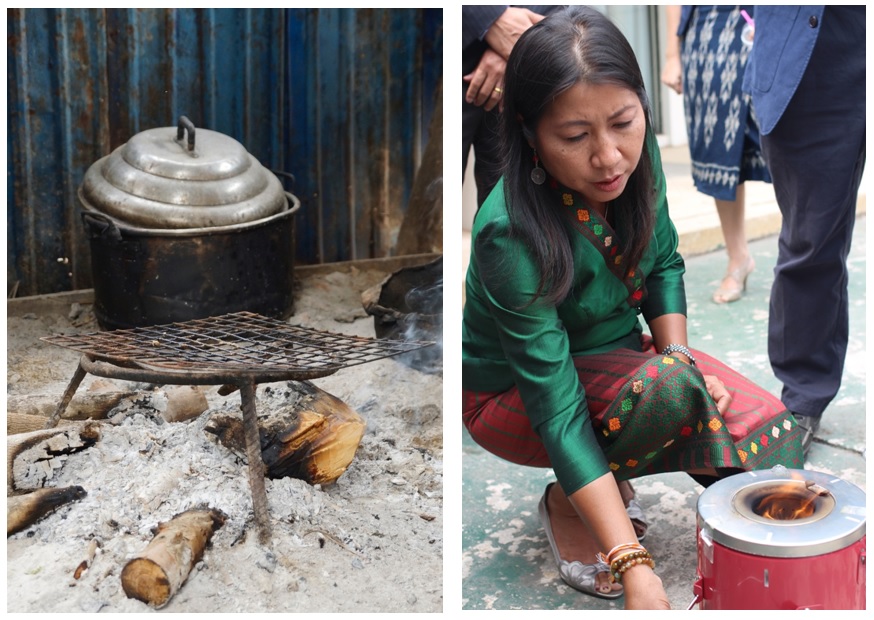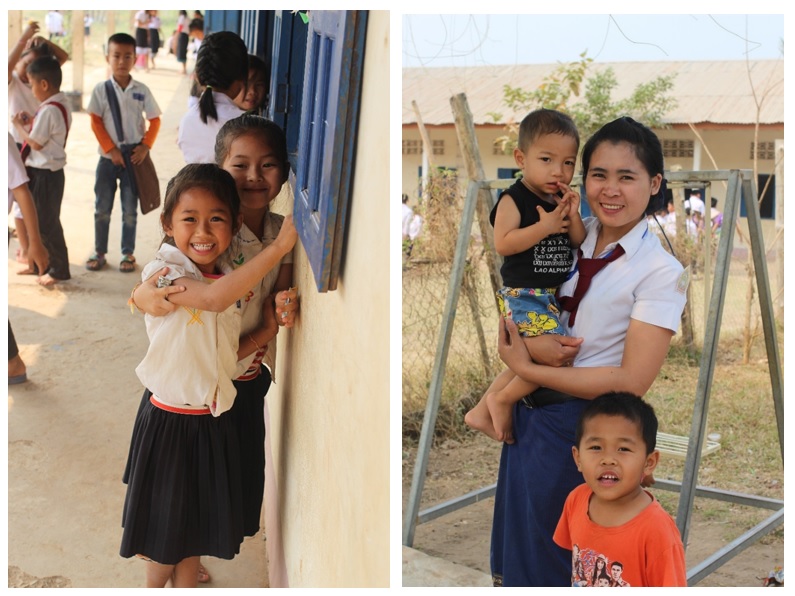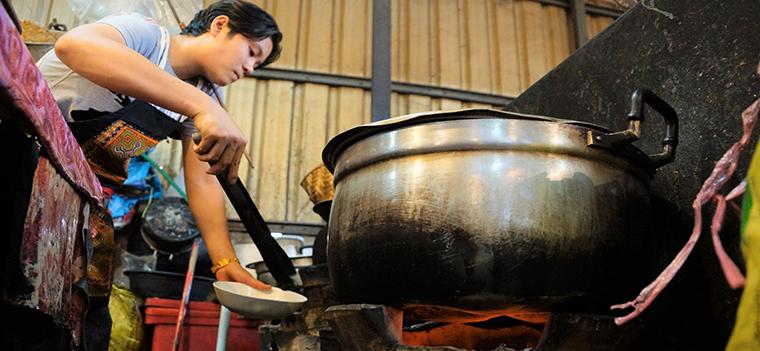News
- In Lao PDR, 96% of people --predominantly women – rely heavily on solid biomass for cooking and heating.
- National data rank respiratory diseases as the number one cause of death in Lao PDR. These are linked to early and long-life exposure to toxic gases from cookstoves, among other causes. A typical wood-burning cookstove emits 300-400 cigarettes worth of smoke an hour into the environment around the stove.
- In collaboration with the Ministry of Energy and Mines, the Lao PDR Clean Stove Initiative, under the Health Governance and Nutrition Development Project of the World Bank, is piloting a holistic approach to introduce 50,000 “super clean stoves” through results-based financing (RBF).
- To scale access to clean cooking and heating solutions on a large scale, investment needs are estimated to be at least US$4.4 billion globally. As a response, the Energy Sector Management Assistance Program (ESMAP) launched the Efficient, Clean Cooking and Heating Program (ECCH) in 2015. ECCH is truly cross-sectoral with the energy, health, environment, climate change and gender teams of the World Bank working together to build global momentum, support task teams and unlock financing.
The Challenge and Approach
Imagine waking up at 4 AM to prepare meals for your family on a biomass stove. For 3 to 4 hours, your home is filled with toxic smoke that burns your eyes. You also might need to collect firewood, which adds even more time and poses a risk of physical harm. This is the reality for 96% of people in Lao People’s Democratic Republic (Lao PDR) - particularly women – in a country that still relies heavily on solid biomass for cooking and heating.
Changing cooking practices in Lao PDR and across the globe can yield significant health and environmental benefits. Worldwide, three billion people rely on solid fuels for cooking and heating. According to the World Health Organization (WHO), household air pollution from cooking kills 4 million people every year - more than the number of deaths from malaria and tuberculosis combined - and sickens millions more from lung and heart diseases. National data rank respiratory diseases as the number one cause of death in Lao PDR. These are linked to early and long-life exposure to toxic gases from cookstoves, among other causes. A typical wood-burning cookstove emits 300-400 cigarettes worth of smoke an hour into the environment around the stove[i]. Black carbon, one of the primary emissions sources from traditional cookstoves, is also an important contributor to global climate change. Residential solid fuel burning accounts for 25% of global black carbon emissions, of which 84% is from households in developing countries. In Southeast Asia, half of black carbon emissions comes from cookstoves.
Figure 1 | Building a Market for Super Clean Cook Stoves in Lao PDR through RBF

With a clear focus on these issues, the Lao PDR Clean Stove Initiative, under the Health Governance and Nutrition Development Project of the World Bank, is piloting approaches to introduce 50,000 “super clean stoves” through results-based financing, and the support of ESMAP’s Efficient, Clean Cooking and Heating program. The team is working in collaboration with the Ministry of Energy and Mines of Lao PDR to help attract upfront financing to the market based on expected intervention outcomes in climate, health and gender. Donors and impact investors who want to see results delivered on the ground will verify and monetize outcomes for purchase. Resulting profits can be reinvested into the super clean stove market to ensure scale-up over time.
However, the innovation does not end here, explains Rutu Dave, Energy Specialist and Task Team Leader of the initiative. “We are working to introduce “super clean stoves,” which are the most advanced forced-draft gasifier available. Not only are they the safest and most efficient cookstoves on the market, but they are the only stoves that meet World Health Organization standards for indoor air pollution, which can make a true impact for cooks and their families.” Additional benefits include the stove’s ability to use pellets, which can be produced from a variety of biomass residue including coffee grains, cornhusk, and other local sources. It also comes with additional accessories, such as grills and heater components, which allows Laotians to cook traditional cuisines and heat their homes.
Entrepreneurship to Drive Market Transformation
Soulikanh Keokinnaly, a social entrepreneur in Vientiane, believes that the super clean cookstoves can truly transform the lives of women and men in Lao PDR. Her interest in the sector was validated by a trip to India in December 2016 where she saw the stoves being used in households and was fascinated by the ease with which women used the stoves, as well as the overall quality and efficiency of the product. “This motivated me to bring this stove to Lao PDR, where we often do not have access to quality products in the market. I want to give people in Vientiane and other areas the opportunity to experience a completely new way of cooking,” emphasizes Soulikanh Keokinnaly. These private sector partners have a key role to play in importing the product into Lao PDR, stimulating the demand and creating a sustainable pellet supply so that users can purchase the fuel they need to cook on their super clean cookstoves as well as providing after-sales service.
Figure 2 | Traditional cookstove used in a typical household in Lao PDR; and Soulikanh Keokinnaly a social entrepreneur demonstrating the usability and benefits of the super clean cookstove. Photo credit: Sara Trab Nielsen and Inka Schomer.

The Way Forward
Under the guidance of a high-level inter-ministerial taskforce, led by the Ministry of Energy and Mines, the Clean Stove Initiative is collaborating with the World Food Program (WFP) and Poverty Reduction Fund to bring the first round of super clean cookstoves to market in the coming months. The plan is to bring the first 3,500 stoves to households and schools for use in daily cooking, and to pilot community-sized stoves in the Nalae district as part of the school feeding programs, which reach about 100 students per school per day. This forms part of efforts to create a market for the stoves which complements the work by the 50,000 “super clean stove” program which will be concentrated in the urban areas. “By bringing this new technology to Lao PDR, we gain a better understanding of how people feel about cooking their traditional meals on the stoves and lay the foundation for further use of this product. I personally know that the mothers who volunteer to help cook daily meals will benefit greatly from the time-savings and health benefits associated with the use of these stoves,” explains Nanna Skau Head of Programme WFP.
Figure 3 | Schools in Lao PDR that will benefit from adoption of community-sized stoves as part of the school feeding programs of the World Food Programme. Photo credit: Inka Schomer.

Background Efficient Clean Cooking and Heating at the World Bank
To increase access to clean cooking and heating solutions globally, investment needs are estimated to be at least US$4.4 billion annually. The Energy Sector Management Assistance Program (ESMAP) launched the Efficient, Clean Cooking and Heating Program (ECCH) in 2015 to respond to the need to scale-up global efforts on these issues. ECCH is truly cross-sectoral with the energy, health, environment, climate change and gender teams of the World Bank working together to build global momentum, support task teams and unlock financing. ECCH serves to coordinate World Bank efforts in the sector, and collaborates with partners both globally and at the country level. In addition to the work in Lao PDR, ECCH has mobilized lending in World Bank operations, such as in the China Hebei Air Pollution and Prevention Control Program; developed gender-sensitive and user-centric approaches, such as in the Indonesia Clean Stove Initiative and piloting approaches to attract private sector financing through a results-based financing (RBF) approach. The Lao PDR Clean Stove Initiative is the first pilot under the ECCH Program expected to use RBF to monetize climate, health and/ or gender outcomes. Experience in Lao PDR has shown that the sector is hungry for new technologies, innovative financing and increased private sector engagement and the team hopes this project can serve as a model for clean cooking and heating, both for the World Bank and its clients.
Acknowledgements: Special thanks to Rutu Dave, Sara Trab Nielsen, Sarah Hillware, Heather Worley and Marjorie Araya (WB) for their input and guidance on shaping the content of this piece. The Lao PDR Clean Stove Initiative team would also like to thank Soulikanh Keokinnaly and Nanna Skau for their contribution. Cover image by Sara Trab Nielsen.
[i] Smith, KR, Biofuels, Air Pollution and Health, Plenum Press, 1987
Learn more about the ESMAP Energy Access Program
